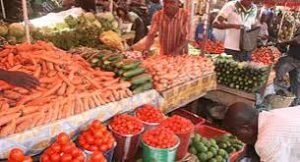The NBS disclosed this in its Consumer Price Index (CPI) and Inflation Report for October 2024, which was released in Abuja on Friday.
According to the report, the figure is 1.18 per cent points higher compared to the 32.70 per cent recorded in September 2024. It said that, on a year-on-year basis, the headline inflation rate in October 2024 was 6.55 per cent higher than the rate recorded in October 2023 at 27.33 per cent.
In addition, the report said on a month-on-month basis, the headline inflation rate in October 2024 was 2.64 per cent, which was 0.12 per cent higher than the rate recorded in September 2024 at 2.52 per cent.
This means that in October 2024, the rate of increase in the average price level was higher than the rate of increase in the average price level in September 2024.
The report said the increase in the headline index for October 2024 on a year-on-year and month-on-month basis was attributed to the increase in some items in the basket of goods and services at the divisional level.
It said these increases were observed in food and non-alcoholic beverages, housing, water, electricity, gas, and other fuel, clothing and footwear, transport and furnishings, household equipment and maintenance.
Others include education, health, and miscellaneous goods and services, restaurants and hotels, alcoholic beverages, tobacco and kola, recreation and culture, and communication.
It said the percentage change in the average CPI for the 12 months ending October 2024 over the average CPI for the previous 12 months was 32.26 per cent. This indicates an 8.82 per cent increase compared to 23.44 per cent recorded in October 2023.
The report said the food inflation rate in October 2024 increased to 39.16 per cent on a year-on-year basis, which was 7.64 per cent higher compared to the rate recorded in October 2023 at 31.52 per cent.
Increases in prices of guinea corn, rice, maize grains, beans, yam, water yam, and cocoyam cause food inflation yearly. Others are palm oil, vegetable oil, Lipton, Milo, and Bournvita.
It said that on a month-on-month basis, the food inflation rate in October was 2.94 per cent, a 0.30 per cent increase compared to the rate recorded in September 2024 at 2.64 per cent.
The increase in the average prices of palm oil, vegetable oil, mudfish, croaker, fresh fish, dried beef, goat meat, mutton, and skin meat caused the increase in food inflation month-on-month. Others are bread, guinea corn flour, plantain flour, and rice.
The report said that “all items less farm produce and energy’’ or core inflation, which excludes the prices of volatile agricultural produce and energy, stood at 28.37 per cent in October on a year-on-year basis. This increased by 5.79 per cent compared to 22.58 per cent recorded in October 2023.
The exclusion of petrol is due to the deregulation of the commodity by subsidy removal. It said the highest increases were recorded in prices of bus journeys within the city, journeys by motorcycle, and bus journeys intercity, among others. Others are rent, meals at a local restaurant, haircut service, women’s hair brush, and hairdressing.
The NBS said the core inflation rate was 2.14 per cent in October 2024 on a month-on-month basis. This indicates a 0.04 per cent increase compared to what was recorded in September 2024 at 2.10 per cent. The average 12-month annual inflation rate was 26.12 per cent for the 12 months ending October 2024; this was 6.14 per cent, higher than the 19.98 per cent recorded in October 2023.
The report said on a year-on-year basis in October 2024, the urban inflation rate was 36.38 per cent, which was 7.09 per cent higher compared to the 29.29 per cent recorded in October 2023. On a month-on-month basis, the urban inflation rate was 2.75 per cent, which increased by 0.08 per cent compared to September 2024 at 2.67 per cent.’
The report said on a year-on-year basis in October, the rural inflation rate was 31.59 per cent, which was 6.01 per cent higher compared to the 25.58 per cent recorded in October 2023. On a month-on-month basis, the rural inflation rate was 2.53 per cent, which increased by 0.14 per cent compared to September 2024 at 2.39 per cent.’
The states’ profile analysis showed that in October, all items’ inflation rate on a year-on-year basis was highest in Bauchi at 46.68 per cent, followed by Kebbi at 40.02 per cent and Sokoto at 39.65 per cent. It, however, said the slowest rise in headline inflation on a year-on-year basis was recorded in Delta at 27.85 per cent, followed by Benue at 28.22 per cent, and Katsina at 29.59 per cent.
The report, however, said in October 2024, all items inflation rate on a month-on-month basis was highest in Kano at 3.77 per cent, followed by Bauchi at 3.74 per cent, and Anambra at 3.59 per cent. Kwara at 1.27 per cent, followed by Ondo at 1.49 per cent and Lagos at 1.91 per cent, recorded the slowest rise in month-on-month inflation.
The report said on a year-on-year basis that food inflation was highest in Sokoto at 52.18 per cent, Edo at 46.55 per cent, and Borno at 45.85 per cent. Kwara at 31.68 per cent, followed by Kogi at 33.30 per cent and Rivers at 33.87 per cent, recorded the slowest rise in food inflation year-on-year.
However, the report said on a month-on-month basis that food inflation was highest in Adamawa at 5.08 per cent, followed by Sokoto at 4.86 per cent and Yobe at 4.34 per cent. Kwara at 1.11 per cent, followed by Ondo at 1.31 per cent and Kogi at 1.50 per cent, recorded the slowest rise in inflation month-on-month.
NAN





